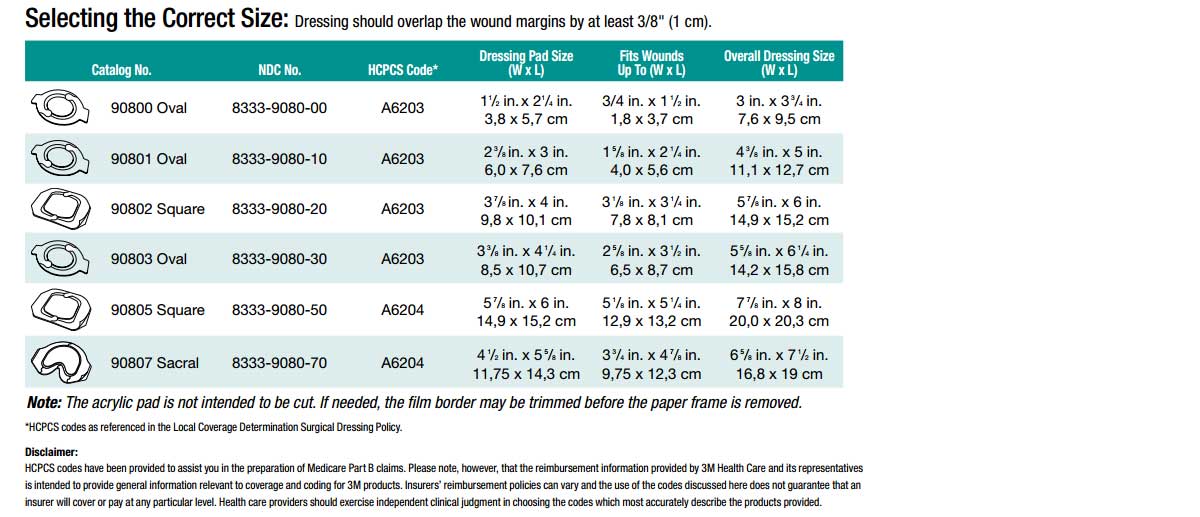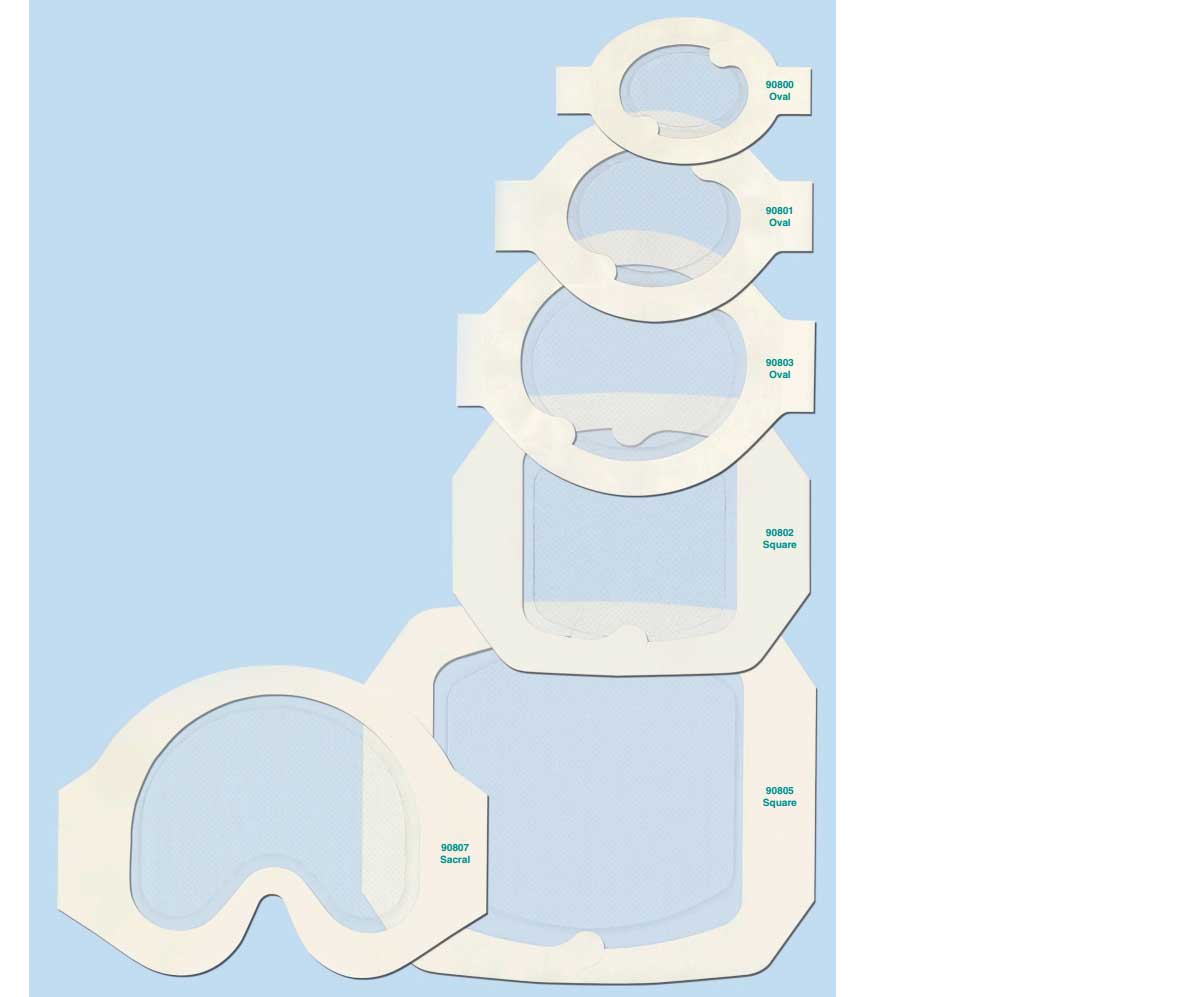3M Health Care is now Solventum, delivering the same trusted products under a new name.
3M Tegaderm Absorbent Clear Acrylic Dressings are transparent bandages that offer easy monitoring of the wound. Wound observation allows less frequent bandage changing and less trauma to the patient. This acrylic dressing is designed with a novel acrylic polymer to accommodate low to moderate wound drainage. This absorbent dressing wicks exudates from the wound and is used to treat patients with sensitive or damaged skin. Tegaderm Acrylic Dressings offer better fluid management and wear time than the leading hydrocolloid dressing. This sterile wound bandage comes with an adhesive border that is gentle to the skin.
3M manufactures other adhesive bandage products, such as Tegaderm Transparent Film, CHG IV Securement, and the Hydrocolloid Dressing.

Features & Benefits
- Suitable for periwound skin.
- Helps eliminate unnecessary dressing changes.
- Barrier to outside contaminants such as fluid, bacteria and viruses.
- No hydrocolloid-related odor.
- Dressing will not breakdown into the wound.
- Easy to center the bandage to the wound site.
- Gentle removal from skin.
- Hypoallergenic and latex-free.
- Viral barrier to HIV-1 and HBV while the dressings remains intact without leakage.
Specifications
- Product Numbers: 90800, 90801, 90802, 90803, 90805, 90807.
- Width Ranges: 3 to 7.5 Inch.
- Length Ranges: 1.5 to 8 Inch.
- Shape Options: Oval, Square, and Sacral.
- Material: Acrylic.
- Application: Acrylic Dressing.
- Type: Adhesive.
- Sterile.
- Latex free.
- Absorbent.
- Manufacturer: 3M.
- Brand: Tegaderm.
- HCPCS Codes: A6203, A6212.

Manuals and Documents
 Flyer provides features and benefits for this Tegaderm bandage.
Flyer provides features and benefits for this Tegaderm bandage. Selection Guide displays the different options for this bandage, sizing and dressing profile information.
Selection Guide displays the different options for this bandage, sizing and dressing profile information. Application Guide details the process of applying the dressing to a wound and its removal.
Application Guide details the process of applying the dressing to a wound and its removal. Frequently Asked Questions are answered.
Frequently Asked Questions are answered. MSDS Material Safety Data Sheet.
MSDS Material Safety Data Sheet. Package Insert Guide covers storage, application, removal and dressing usage.
Package Insert Guide covers storage, application, removal and dressing usage. Package Insert Card offers details for use, removal and storage.
Package Insert Card offers details for use, removal and storage. Skin Tears Management information for this dressing.
Skin Tears Management information for this dressing. Debridement Study examines the use of transparent acrylic dressing for wound debridement.
Debridement Study examines the use of transparent acrylic dressing for wound debridement. Skin Damage Management looks at reducing further skin damage by the use of acrylic bandages.
Skin Damage Management looks at reducing further skin damage by the use of acrylic bandages. Skin Tears Management information for this dressing.
Skin Tears Management information for this dressing. Stage 2 and 3 Pressure Ulcers Wound Care using these types of dressings.
Stage 2 and 3 Pressure Ulcers Wound Care using these types of dressings. Pressure Ulcer Management use of this bandage.
Pressure Ulcer Management use of this bandage. Sacrum Pressure Ulcer Wound Management information for this bandage.
Sacrum Pressure Ulcer Wound Management information for this bandage. Skin Graft Donor Site Management presents findings for use of this Tegaderm product.
Skin Graft Donor Site Management presents findings for use of this Tegaderm product. Skin Tears and Acrylic Dressings information for this dressing.
Skin Tears and Acrylic Dressings information for this dressing. Surgical Incision Wounds Treatments to improve healing outcomes.
Surgical Incision Wounds Treatments to improve healing outcomes. Surgical Wound Management by using a more skin-friendly dressing.
Surgical Wound Management by using a more skin-friendly dressing.
Medical Studies
- Bank D, Nix D. Preventing skin tears in a nursing and rehabilitation center: an interdisciplinary effort. Ostomy Wound Management 2006;52(9):38-46.
- Etris-Brown M, Milne C, Orsted H, Gates J, Netsch D, et al. A prospective, randomized, multisite clinical evaluation of a transparent, absorbent, clear acrylic dressing and a hydrocolloid dressing in the management of stage II and shallow stage III pressure ulcers. Advances in Skin and Wound Care 2008;21(4):169-174.
- Fleck CA. Preventing and treating skin tears. Advances in Skin and Wound Care 2007;20(6):315-320.
- LeBlanc K, Baranoski S. Prevention and management of skin tears. Advances in Skin and Wound Care 2009;22(7):325-332. 5. Malone ML, Rozario N, Gavinski M, Goodwin J. The epidemiology of skin tears in the institutionalized elderly. J Am Geriatr Soc 1991;39(6):591-5.
- Ratliff CR, Fletcher KR. Skin tears: a review of the evidence to support prevention and treatment. Ostomy Wound Management 2007;53(3):32-42.
- Roberts MJ. Preventing and managing skin tears. JWOCN 2007;34(3):256-259.
3M™ Tegaderm™ Clear Acrylic Dressing | Application and Removal Video (1:49 Minutes)
Video Transcription
Now we will go on to the dressing application.
You want to prepare your wound and protect your peri-wound skin per your facility protocol. Select a dressing which allows for 3/8 of an inch or one centimeter overlap onto the skin. You peel your paper liner from your dressing exposing the adhesive surface. Then center your dressing over your wound. You can apply light pressure around the edges of the dressing to secure as these are pressure-sensitive adhesives. Peel the paper liner, walking your fingers along the edges to ensure a good seal. This dressing can remain in place. Only needing to change if there's leaking, lifting off or wound fluid under the adhesive border.
For dressing removal, you carefully lift the dressing edge or the film border while pressing down on the skin. Continue to work around your dressing, lifting your edge until that film border is completely lifted. If you have a challenge lifting the film border, you may apply a piece of tape to the edge and use that to lift your border.





Login and Registration Form